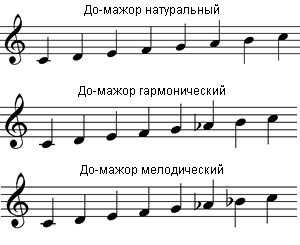Tritoni V Lya Bemolj Mazhore
Actually it depends on the instrument. Some instruments can produce different notes for A# and Bb, others can not. There are different ways to intonate. On one side you have a just or harmonic intonation which is built on harmonics scale (each tone has a a matemathical relation between the base tone), this makes each tonality have its own intonation; on the other side you have temperate intonation which makes a compromise between frequencies and different keys, dividing the interval octave in equally distance semi-tones, to make possible one instrument to play in different keys, always using the same notes. Is a good explanation about this. Alsto worth to read.
Apr 9, 2015 - v. 1 in B flat major, Vivo e risoluto. Bach's day it had been completely re-imagined as a slow stately dance (figure 1.7) in triple meter.
Derevyannie fermi chertezhi3940891. In practical terms, to be able to fine tune a chord (just/harmonic intonation in the guitar or different instruments playing/singing together) you must raise or lower some tones. Often the third in the chord needs adjustment. For example the third in F# chord (A#) should be higher than a Bb.
If your instrument can't play it (like a piano) you land on tempered intonation, if you can play it (or bend the tone guitar/harmonica/etc) then you can get a just/harmonic intonated chord. Posted this very clear table on his to.
Notice how the third in the chord is higher or lower depending on the intonation model you are using. (the A# in my example of the F# major chord). About the mathematical relation between tones in the harmonic scale: (source ). I'll add that the difference isn't only in pitch. Even in equal intonation, in which the pitches of A# and Bb are the same, you would use one or the other in certain contexts.
You don't have a Bb in the F# major scale, except as an accidental, because it already has a B natural. Even as an accidental, it has a different meaning than an A#: it's a diminished 4th, not a major third (though they happen sound the same in equal intonation). This might not make sense to many amateur musicians, but when you start seeing music in terms of phrases and not just individual notes, it becomes important.

– Apr 24 '15 at 20:07 •. Enharmonic notes are different, e.g. G# and A-flat, even though it is not always the case that instruments make different sounds for these different notes. These different note names are used to indicate differences in terms of the melodic or harmonic content of the music. Trainz 2012 rusifikator edition. For example, in A minor, G# is frequently encountered as the 'leading tone' back to the tonic.
Notating this sound with an A-flat would mis-represent what is going on in the music. Similarly, writing an E major chord as E,A-flat,B does not correctly the harmonic relationship between the root of the chord and the third (or the fifth if it were indicated with a C-flat). This would just be a notational convention if it weren't the case that many instruments can and do express the differences between enharmonic notes in terms of the sounds that they make.
A key instrument in this regards is the voice: it is the most commonly encountered instrument with continuous pitch adjustment, and composing and analyzing vocal music was a key facet in the historical development of western music theory which is the context in which this question arises. Going back to the leading tone in A-minor, a vocalist singing a capella will tend to raise the pitch of that note, relative to the corresponding piano note, a component of 'expressive intonation'.
Slightly sharpening the note makes it's resolution to the tonic (A) more satisfying. Similar considerations apply in terms of harmonic content: an E-major chord is E,G#,B -- the G# indicating the note a third above the E; in a choral group, the people singing the G# will (usually) select there pitch to be consonant with the E's (which is different from the equal-tempered G# on a piano). These considerations apply to other continuous pitch instruments, in particular unfretted string instruments in an orchestra. Going further would require delving into the historical aspects of tuning, temperament and intonation as well as overall description of functional harmony and melody.